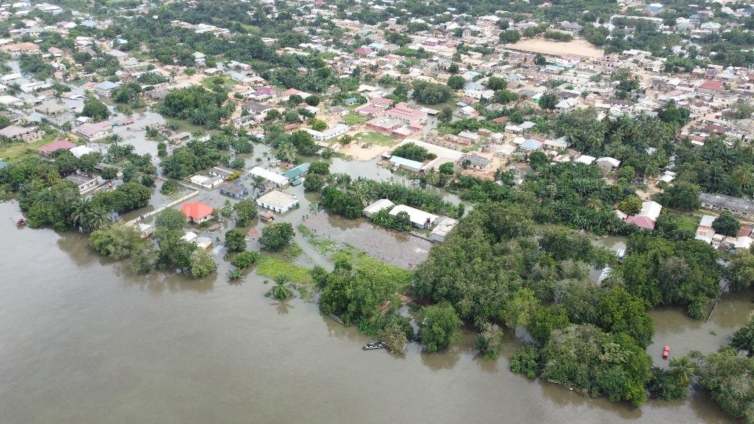Farmers affected by the devastation caused by the spillage of the Akosombo and Kpong dams are to benefit from a $40 million food systems resilience programme.
The Minister of Food and Agriculture, Dr Bryan Acheampong, who announced this, said a World Bank funded programme has been restructured by the government “to fully restore friends, brothers and families on the Volta and Eastern stretch of the Akosombo Dam’s path, whose farms have been wiped out due to the necessary action taken by the Volta River Authority (VRA) to save us all”.
Dr Acheampong said this when he addressed a presidential conference on youth in agriculture in Accra on Wednesday [Oct 18, 2023].
The conference was organised by the Ministry of Food and Agriculture (MoFA) in collaboration with the Youth Employment Agency (YEA).
Context
Last Monday when President Nana Addo Dankwa Akufo-Addo toured the flooded areas in the Volta Region, he announced that the Ministry of Food and Agriculture (MoFA) would work on a long-term relief programme for farmers affected by the floods.
The President said he was aware many farms along the Volta River had been destroyed by the floods, for which reason a relief programme needed to be set up to restore the livelihood of the people.
But in the meantime, he said, the inter-ministerial committee formed to look at the flood situation through the National Disaster Management Organisation, the VRA and other agencies were providing relief items as a short term measure for the flood victims.
Youth in agriculture
Turning his focus on agriculture and the youth of the country, Dr Acheampong said: “The Planting for Food and Jobs phase 2 (PFJ 2.0) programme was a catalyst for creating both sustainable jobs and financial self-sufficiency in one fell swoop”.
He said the programme would stand out as probably the most youth-centred intervention in the history of the country.
“Every aspect of the programme responds positively to the challenges and barriers impeding the desire of the youth to take up agriculture as a viable business and livelihood opportunity,” he said.
He added that the input credit system also removed a major entry barrier, making it easier for the participation of the youth.
“The system creates opportunities for the youth to access all the needed inputs to produce the commodity of their choice without the need to provide upfront cash or collateral.
“The provision of comprehensive mechanisation services — land preparation, planting, seeding and harvesting — as part of the package also eliminates the drudgery in farming, and drives productivity,” Dr Acheampong indicated.
Structured market
Explaining the concept further, the minister said the hassle of getting access to a well-organised and structured market for selling produce and getting a fair, non-exploitative price had been addressed under PFJ 2.0.
He added that the selection of the value chains under the programme had also taken into account commodities that were youth-friendly.
For example, Dr Acheampong said, crops such as maize, rice, soybeans, sorghum and vegetables had a shorter production cycle and provided quick cash turnaround.
In that regard, he said, the PFJ 2.0 would be a game-changer in the quest to transform agriculture in the country.
“The added significance of the programme is that it will firmly position Ghana to become very competitive, and leverage the opportunities presented by the Africa Continental Free Trade Area (AfCFTA) programme,” he said, and pointed out that “Ghana cannot afford to miss out on this in terms of the expected benefits in trade, job creation and its overall contribution to economic growth.”
He, therefore, urged the youth to avail themselves and team up with the government to aggressively and fully harness the potential of agriculture in the country through the PFJ 2.0.
PFJ 2.0
Throwing more light on the PFJ 2.0, Dr Acheampong said it was designed to consolidate and build on the successes of PFJ 1, and sought to ensure that Ghana became food secure within the planned implementation period.
He said it was a strategic intervention to continuously improve the level of Ghana’s self-sufficiency for selected commodities from organised production using an input credit system and aggregation model.
Other related objectives in terms of the programme, Dr Acheampong said, were job creation, particularly for the teeming youth of the country, reducing food price inflation, building food systems resilience and promoting import substitution and exports.
Through the collaboration between the MoFA and the YEA, Dr Acheampong said: “Under the banner of the PFJ 2.0, we would put 200,000 youth into permanent work in agriculture, with each individual cultivating an average farm size of 10 acres”.
That, he said, would mean putting over 400,000 hectares of arable land under cultivation, with the targeted commodities being maize, rice and vegetables.
He, however, said: “If we put all 400,000 hectares of land under rice cultivation alone, we would exceed our self-sufficiency production target of 1.834 million tonnes”.
He said MoFA would, in addition to lands already secured by the YEA, make more land available from agriculture zones and economic enclaves to be established under the PFJ 2.0.
Source:graphic.com.gh





